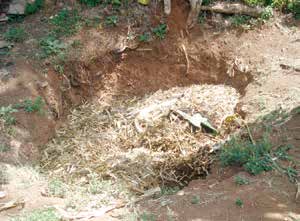chAPter 13 Making and using CoMPosts
water, heat,
and carbon dioxide
oxygen
oxygen
a) Early stage of composting
b) During first turning
(pile about 5 feet tall by 8 to 10 feet at base)
(covering now inside and partially
composted material used on top and sides)
c) After first turning
d) Composting finished
(pile covered with composted material)
(pile smaller than original size)
Figure 13.2. Compost pile dimensions and turning techniques.
may take a year or longer to complete, especially if it has
factors, such as aeration, moisture, and temperature.
settled down too densely. Equipment is now available
Turn your compost pile to avoid cold, wet centers; break
to quickly turn long compost windrows at large-scale
up clumps; and make the compost more uniform later in
composting facilities (figure 13.3). Tractor-powered
the process before use or marketing. Use caution turn-
compost turners designed for composting on farms are
ing in cold, windy weather if the pile is warm, for it may
also available, and some farmers use manure spreaders
never reheat.
to remix and throw out piles.
Although turning compost frequently speeds up
the process, too much turning may dry out the pile and
cause more nitrogen and organic matter loss. If the
pile is too dry, you might consider turning it on a rainy
day to help moisten it. If the pile is very wet, you might
want to turn it on a sunny day, or cover it with mois-
ture protective material like chopped straw or compost
fleece, a type of breathing cover that is now widely
available. Very frequent turning may not be advanta-
geous, because it can cause the physical breakdown of
important structural materials that aid natural aeration.
Figure 13.3. Turning a compost pile at a commercial facility. Photo by
The right amount of turning depends on a variety of
Alison Jack.
145
Building SoilS for Better CropS: SuStainaBle Soil ManageMent





